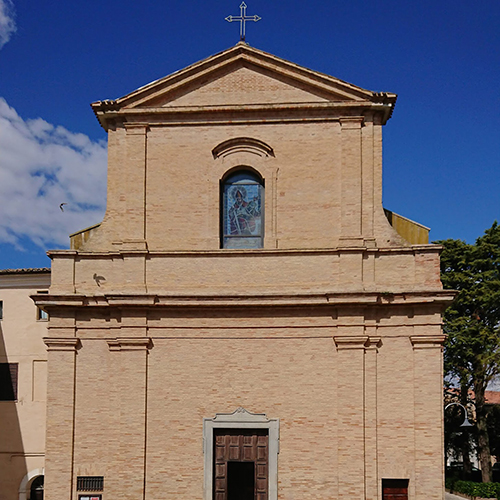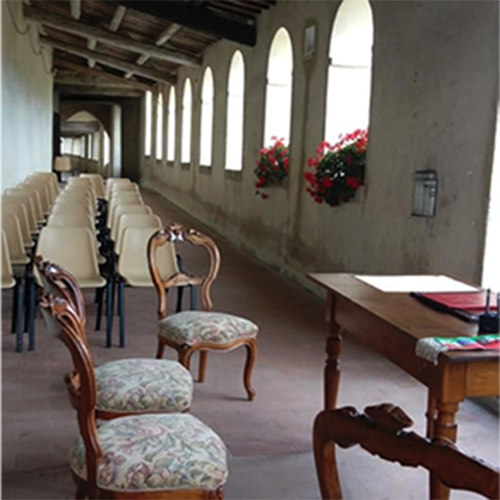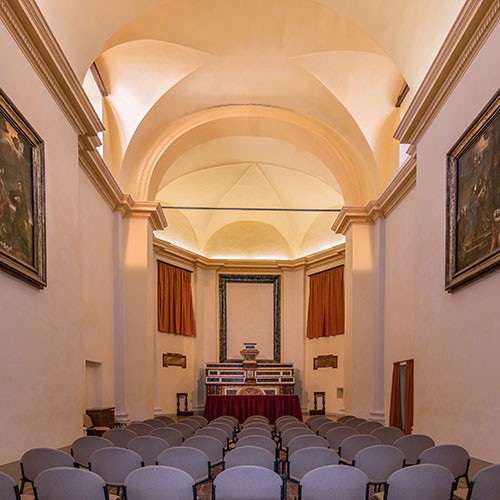Getting Married in the Historic Town/Village: 6 Fantastic Locations

In Morro d’Alba, the historic village of Love, amidst the history and the breathtaking views offered by a magical and evocative natural setting, you can find six fascinating locations for your most beautiful day.
Religious Ceremony
The Church of San Gaudenzio

Designed in the mid-eighteenth century by the architects Arcangelo Vici and Nicola Maiolatesi, the recently renovated building is striking for its brightness and the richness of its decorations, particularly the pilasters that emerged following the last restoration. The nineteenth-century pink stone flooring, uncovered after the restoration, is particularly delicate and elegant.
Inside, among other works, we mention an altarpiece by Ramazzani (Crucifix with Madonna and Saint Agatha 1596). The large facade window, which illuminates the interior at dawn, was modified in 2018 with an image of Saint Gaudentius. Beneath it is an organ from the second half of the 18th century. Due to its historical and artistic interest, the Church will be featured in the upcoming “Autumn Days” dedicated to the rediscovery of cultural heritage organized by FAI (Italian National Trust).
The location is particularly chosen by couples who intend to celebrate their religious wedding in an evocative setting.
The Church of Saints Simon and Jude
The small rural church of Sant’ Amico, dedicated to Saints Simon and Jude, is very old. According to an inscription, it seems to have been rebuilt in 1587 by the inhabitants of the Castellare, a group of fortified houses present in the area of Donderè, as the zone was then called. Many accommodation facilities and wineries currently reside in this area. The vegetation is lush, and the fields are primarily cultivated with Lacrima di Morro d’Alba DOC and Verdicchio Classico dei Castelli di Jesi vines. The small church of Sant’ Amico is an intimate and evocative location, immersed in a dominant natural setting enveloped by vineyards and the scents and colors of the Marche countryside. Due to its historical and artistic peculiarity, this church will also be included in the circuit of days that the FAI (Italian National Trust) dedicates to the rediscovery of the Historical and Artistic heritage of the Municipality of Morro d’Alba.

Civil Ceremony
La Scarpa

The Rampart Walk (Camminamento di ronda), which circles the entire castle walls of the historic town/village of Morro d’Alba, represents a unique feature in Europe. It is named "La Scarpa" (The Shoe), referring to the external walls of the Castle that are indeed "scarped," or sloping.
Originally, it was the main street of the borgo, the one overlooked by the openings of the most important residences. The entrance to the town hall was located there, and later, the entrances to artisan workshops. Today, thanks to its perfect preservation, it allows for a walk that offers extraordinary views of the Marche countryside, sloping gently from the Sibilline Mountains down to the sea and the Conero Promontory.
The towers are located at the vertices of the Castle's original pentagonal layout and have been named after figures and elements linked to the history of the borgo, which is inevitably tied to Frederick II (His coat of arms is reproduced on the civic tower visible from Piazza Tarsetti outside the Borgo).
In particular, the tower called "Teodorico" is often chosen for wedding celebrations, taking advantage of the extraordinary panorama and the particular charm that characterizes it at certain times of the day, such as sunset. The same locations are chosen by the administration for hosting chamber music concerts during the summer.
The entire rampart walk is equipped with a sound system that allows the walk and the celebration of the rite to be accompanied by music, which can be chosen by the marrying couple. In this case, the cost of renting the public space also includes the payment of the SIAE (Italian Society of Authors and Publishers) fees and seating for guests.
The Mayor's Office
It is accessed from the entrance hall of the town hall and is the place where the Mayor of Morro d’Alba carries out his work, receiving dignitaries and citizens.
The room, in Pompeian red, features a central ceiling decoration characterized by elegant and harmonious classical elements created by Marcantonio Bedini in 1947. The walls are enriched with valuable and antique seventeenth and eighteenth-century small-format paintings from the ancient churches of Morro, which are part of the municipal collection.
This location is generally chosen for very intimate celebrations, with very few guests attending the ceremony.

Santa Teleucania Auditorium

Formerly the Church of the S.S. Annunziata (Most Holy Annunciation), it is located in Piazza Tarsetti, facing the castle walls. The building was inaugurated in 1670 and features two orders of pilasters on the façade and a portal made of pietra serena (a type of sandstone). It has a gabled structure and a two-pitch roof. Inside, we find three large canvases by unknown artists from the second half of the 1600s.
Owned by the Municipality, it was deconsecrated and restored in 1985. The upper section, formerly dedicated to worship, is used for conferences, and the section below, once used to store products from the farmsteads attached to the Church, is now used as an exhibition space.
Both sections of the building can today be used for wedding celebrations, which are particularly evocative even for civil ceremonies: specifically, the upper section for the ceremony (up to 99 seats) and the lower section for entertaining guests, perhaps with a reception, sometimes coinciding with an art exhibition.
The entrance to the building features a staircase, ideal for floral decoration, and the lower part opens onto a small garden that allows for the expansion of the space dedicated to welcoming guests. The eastern orientation makes the place particularly pleasant at sunset. The structure is equipped with an integrated audio system (filodiffusione) for an event underlined by the music chosen by the applicants.
Council Hall-Picture Gallery
The Council Hall (Sala Consiliare), located in the eighteenth-century building that houses the Town Hall, besides representing the political heart of the borgo (historic town/village), has always served as the Picture Gallery (Pinacoteca). The most important work preserved here is the painting by Claudio Ridolfi, dating from 1630, depicting the Coronation of the Virgin.
The large hall features the busts of local benefactors on the walls and can accommodate up to 99 people. This location is ideal for those who intend to involve a large number of guests, or for lovers of pictorial art who can admire the work of the famous Venetian painter.
The hall is equipped with a voice amplification system, and it is possible to highlight the event with music.
